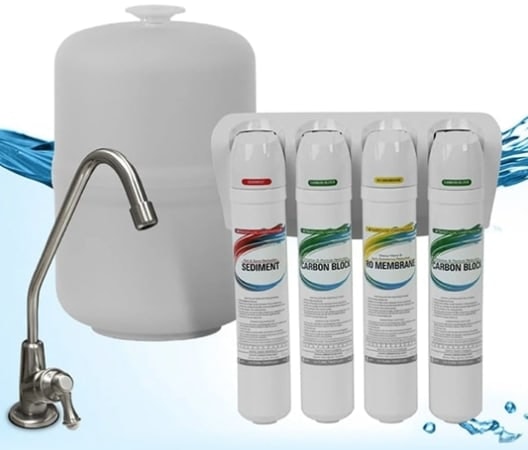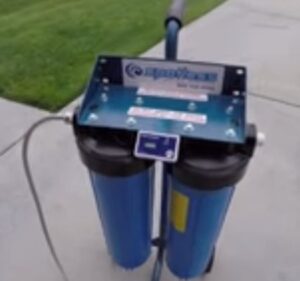How to Test for Sodium in Well Water?
Sodium is a colorless and odorless contaminant. It may give a slightly salty taste to your water but it is rare. You can test sodium’s presence via home testing kit or getting your water tested from a certified laboratory. The EPA’s MCL for sodium is 20 mg/L and for chloride it is 250 mg/L.
3 Ways to Remove Sodium from Well Water
You cannot remove sodium via sediment filtration, boiling or carbon filtration. You can use an RO filter, distillation and de-ionization techniques to remove sodium from well water.
Reverse Osmosis Filtration System – RO filters are used to improve drinking water quality. RO systems come in different shapes and sizes. Most RO filters are under sink filters but some models also come in countertop style. RO systems have multiple filtration stages to remove sediment, chlorine taste and smell, TDS, VOCs, and heavy metals from well water.
Recommended RO System: SpringWell’s RO Water Filter

SpringWell’s RO unit is specifically designed for well water. It offers 4 filtration stages, including one sediment filter, two carbon filters, and an RO membrane. The unit can filter up to 75 gallons of water daily and comes with a pressurized tank for water storage.
It can remove sodium, heavy metals, VOCs, TDS, and other contaminants from water. The system enhances drinking water quality and makes it fit for consumption.
Distillation – Distillation pitchers can remove sodium from well water, but they are costly, and output is limited. Distillation pitchers are suitable for individual use as they need a lot of time to distill the water. Large scale distillation units are costly to buy and will increase your home’s energy bills. When water is distilled, the steam rises and is then cooled to form water again. Distillation is a time taking process.
Related Guide: The 6 Best Water Filter Pitchers For Well Water

De-ionization – A de-ionizer is a device used to remove sodium-based salts from the water. It works in the same way as a water softener. However, acids and bases are used instead of resins to balance the sodium concentration in water. The effectiveness of the system depends upon the incoming water quality and acid/base power. The system needs regular maintenance and refilling of the acids and bases.
How to Prevent Saltwater Contamination?
You can prevent saltwater contamination in the following ways.
- Decommissioning of abandoned or saltwater contaminated wells by a certified driller.
- For people living near oceans and using private wells, water conservation, and using rainwater for non-potable purposes is the best practice. They can also use bottled water for drinking purposes.
- Well inspection may help you reduce the sodium levels in the water. If a damaged well casing or well screen is the cause, a repair may be needed.
- If a treatment or prevention does not work for you, a new well may be needed. It is often the last solution to well water contamination.
- Use potassium-based salts for water softening. It will reduce the sodium content in your water and make it easy for water filters to work effectively.
Health Concerns for Excessive Sodium
- Hypertension
- Cardiovascular problems
- Kidney stone problems
Similarly, a low concentration of sodium in the body can cause the following problems.
- Nausea and vomiting
- Headache, lethargy, confusion,
- Restlessness, irritability, and mood swings
- Cramps and body pains
How Sodium Enters Well Water?
The concentration of sodium in water can increase because of the following reasons.
- Proximity to the ocean and other saltwater sources
- Erosion of salt deposits and sodium bearing rock minerals
- Naturally occurring salty water in some aquifers or underground sources.
- Salt intrusion in wells close to coastal areas
- Surface water (containing road salts) contamination
- Leaching due to soils high in sodium
- Pollution by sewage and waste materials
- Contamination due to salt-based (sodium or potassium) water softeners
- Contamination as a result of industrial waste and dumping
- Use of sodium-based fertilizers and chemicals
Final Words
It is crucial to get your water tested periodically. Only water testing from a certified lab will help you adopt the right treatment option. Our aim is not only to remove sodium from water but to make it safe for drinking.
